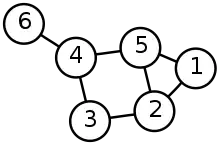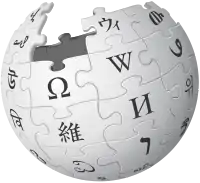graph theory
English

A graph, such as is the subject of graph theory
Noun
graph theory (countable and uncountable, plural graph theories)
- (uncountable, mathematics) The branch of mathematics dealing with the properties of graphs (networks of vertices and edges).
- The type of graph studied in graph theory is formally described as an ordered pair comprising a set of vertices, or nodes, and a set of pairs (either ordered or unordered) of vertices, each representing an (directed or undirected) edge; if desired, the vertices and/or edges can be labelled.
- 1993, Richard J. Trudeau, Introduction to Graph Theory, Dover, page 47,
- In graph theory there are two concepts of "sameness" whereby graphs are judged to be "the same", namely equality and isomorphism. […] An indication of the pervasive role isomorphism has in graph theory is the fact that isomorphism has virtually captured the word "is".
- 1998, Béla Bollobás, Modern Graph Theory, Springer, page 103,
- Extremal problems are at the very heart of graph theory. Interpreting it broadly, extremal graph theory encompasses most of graph theory, in its narrow sense, it contains many of the deepest and most beautiful results in graph theory.
- 2004, Edmund Burke, Dominique de Werra, Jeffrey Kingston, 5.6: Applications to Timetabling, Jonathan L. Gross, Jay Yellen (editors), Handbook of Graph Theory, CRC Press, page 445,
- We aim to highlight the role of graph theory in modern timetabling research and provide some pointers to the relevant literature for the interested reader.
- (countable, applied mathematics) A theory developed by applying graph theory to a particular problem or application.
- 2009, Fu Lee Wang, Christopher C. Yang, Chapter XI: Extracting the Essence: Automatic Text Summarization, Yin-Leng Theng, Schubert Foo, Dion Goh, Jin-Cheon Na (editors), Handbook of Research on Digital Libraries, IGI Global (Information Science Reference), page 114,
- The entity-level approaches build an internal representation for text units and their relationships, and use graph theories to determine the significance of units.
- 2013, Tony D. Sampson, 6: Contagion Theory: Beyond the Microbe, Arthur Kroker, Marilouise Kroker (editors), Critical Digital Studies: A Reader, 2nd Edition, University of Toronto Press, page 131,
- Galloway and Thacker's own dissatisfaction with the graph theories of network science, for example, point to a tendency to attribute unfettered and apolitical naturalness to what are in effect asymmetrical topological spaces.
- 2014, Matteo Fumagalli, Increasing Perceptual Skills of Robots Through Proximal Force/Torque Sensors, Springer, page 46,
- Chapter 3 has shown a method that makes use of a graphical formulation employing graph theories for performing the computation of both kinematic quantities (i.e. angular velocities of the center of mass of links, but also linear and angular acceleration), and dynamic (internal forces on the connection elements between the links, but also externally applied wrenches).
- 2009, Fu Lee Wang, Christopher C. Yang, Chapter XI: Extracting the Essence: Automatic Text Summarization, Yin-Leng Theng, Schubert Foo, Dion Goh, Jin-Cheon Na (editors), Handbook of Research on Digital Libraries, IGI Global (Information Science Reference), page 114,
Derived terms
- graph-theoretic, graph-theoretical
- algebraic graph theory
- extremal graph theory
- geometric graph theory
- probabilistic graph theory
- topological graph theory
Translations
study of graphs (networks of nodes and edges)
|
See also
- Appendix:Glossary of graph theory
Further reading
 Graph isomorphism on Wikipedia.Wikipedia
Graph isomorphism on Wikipedia.Wikipedia  Graph labeling on Wikipedia.Wikipedia
Graph labeling on Wikipedia.Wikipedia  Gallery of named graphs on Wikipedia.Wikipedia
Gallery of named graphs on Wikipedia.Wikipedia  Graph theory on Wikimedia Commons.Wikimedia Commons
Graph theory on Wikimedia Commons.Wikimedia Commons - Graph theory on Encyclopedia of Mathematics
Anagrams
- rhetography